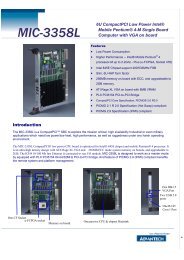industrial wireless book special edition - Networking ...
industrial wireless book special edition - Networking ...
industrial wireless book special edition - Networking ...
Create successful ePaper yourself
Turn your PDF publications into a flip-book with our unique Google optimized e-Paper software.
IEEE 802.11n: the next step<br />
for <strong>industrial</strong> <strong>wireless</strong> LANs<br />
In less than a decade, <strong>wireless</strong> LANs have evolved from a niche technology useable only by a few <strong>special</strong>ised<br />
applications to the default media for the last few metres of the network for consumers, enterprise and<br />
industry. And WLANs continue to evolve. The latest generation of high speed <strong>wireless</strong> LAN technology, based<br />
on the IEEE 802.11n standard, is now widely used in the world of Office Automation but has yet to make an<br />
impact with <strong>industrial</strong> WLANs. As this primer from Adam Conway suggests, It is just a matter of time.<br />
Industrial Wireless<br />
THE TECHNOLOGY behind IEEE 802.11n is<br />
projected to deliver as much as a six-fold<br />
increase in effective bandwidth, as well as<br />
increased WLAN reliability compared to existing<br />
802.11g and 802.11a deployments. This promise<br />
has led some to consider the <strong>wireless</strong> LAN as a<br />
viable alternative to the wired network.<br />
At a minimum, the advances realised by it<br />
will cause many enterprises to reconsider the<br />
role of WLANs in their network, as well as the<br />
effect of such a deployment on their infrastructure.<br />
Before deploying 802.11n, however,<br />
organisations will need to understand the<br />
answers to some basic questions, including:<br />
● What are the operational differences between<br />
802.11n technologies and existing WLAN<br />
elements?<br />
● Is 802.11n backwards-compatible with<br />
existing wired and <strong>wireless</strong> network design?<br />
● What modes can the deployed?<br />
While these questions are simple, the answers<br />
to them are not. IEEE 802.11n uses complex<br />
technologies more frequently used in the world<br />
of radio/broadcast than in networking. Indeed,<br />
there is no shortage of material claiming to<br />
demystify 802.11n, but which only succeeds<br />
in introducing a plethora of new four letter<br />
acronyms.<br />
Here, we will look at the basic elements of<br />
802.11n functionality, with an emphasis on<br />
how it differs from WLAN technologies<br />
presently in use. The primary focus will be on<br />
the major methods that 802.11n uses to deliver<br />
on the claim of large increases in throughput<br />
and reliability.<br />
Performance and reliability<br />
802.11n touts major improvements in both<br />
performance and reliability, yet also purports<br />
to have backward compatibility with 802.11a<br />
and 802.11b/g equipment. The backward<br />
compatibility, higher performance and increased<br />
reliability come about through the action and<br />
interaction of two key technologies: Multiple<br />
In/Multiple Out (MIMO) transmit/receive capabilities<br />
and Channel Bonding.<br />
Incremental improvements are also seen by<br />
combining a myriad of additional technologies,<br />
but for the sake of simplicity, we will consider<br />
only the primary changes.<br />
sponsored by Advantech<br />
<strong>industrial</strong> ethernet <strong>book</strong><br />
Multiple In, Multiple Out (MIMO)<br />
MIMO is the biggest innovation that comes<br />
with 802.11n. Though there are different kinds<br />
of MIMO techniques, we will limit our<br />
discussion to the most useful and prevalent<br />
form in building enterprise WLANs, often called<br />
‘spatial diversity MIMO’ or ‘multipath MIMO’.<br />
Multiple In. When you use only one antenna<br />
on the transmitter and one receiver in an<br />
indoor environment, you are subject to<br />
multipath interference. Multipath interference<br />
happens when a number of packets are encoded<br />
and sent out over the air. The waveform will<br />
interact with anything it encounters on its way<br />
from transmitter to receiver. Some of these<br />
things, like a metal fire door, will reflect the<br />
signal; some things, like a working microwave,<br />
will interfere with it; some things, like organic<br />
material such as plants and people, will absorb<br />
it. The result is that the receiver can end up<br />
with multiple copies of the original signal.<br />
This is similar to how a single sound produced<br />
in a canyon can result in an echo, sounding to<br />
the listener as though the sound is produced<br />
many times over, out of phase with the original.<br />
This echo effect makes it difficult to sort out<br />
the original message, since signals received in<br />
different phases can combine or even<br />
completely cancel one another.<br />
We have all encountered this effect when<br />
listening to the radio in the car. The signal<br />
might be just fine until you come to a<br />
particular place such as a stop light where,<br />
suddenly, the signal seems to disappear. If you<br />
move a bit, however, the signal comes back.<br />
What is really happening when the radio<br />
station appears to go away is that multipath<br />
interference is creating a null – the signals<br />
received are offset from each other and, when<br />
combined, net a zero signal. When you move,<br />
you’ve shifted what the receiver ‘hears’ and the<br />
signal appears to come back. With a complex<br />
signal, it can be virtually impossible to<br />
determine where one message ends and another<br />
begins.<br />
One way that WLAN providers have worked<br />
around multipath is to provide a diverse set of<br />
antennas. Antenna diversity, however, is not<br />
MIMO. It is simply that only one of the set of<br />
antennas is actually transmitting or receiving<br />
– the WLAN is just able to select the antenna<br />
set with the best signal-to-noise ratio.<br />
Multipath has traditionally been the enemy<br />
of WLANs, because the echo-like effect typically<br />
serves to detract from the original signal. When<br />
using MIMO and its multiple receiving<br />
antennas, however, the effects of multipath<br />
become additive – that is, multiple messages<br />
can be received by multiple antennas, and<br />
combined.<br />
Multipath with IEEE 802.11a/b/g<br />
Multipath with IEEE 802.11n<br />
Fig. 1. Multipath use for 802.11a/b/g vs. 802.11n<br />
When using MIMO, we still get multipath as<br />
always, but this time we can sort out a message<br />
more easily and actually use the multipath<br />
reflections to our advantage to gain significant<br />
signal strength and thus improve reliability<br />
(Fig. 1). What does this mean in practice?<br />
Reliability translates to a greater coverage area<br />
for a given data rate, or to higher data rates for<br />
a given coverage area. That translates to more<br />
bandwidth per user…<br />
Multiple Out. MIMO allows for multiple (from<br />
2 to 4) transmitting and receiving antennas<br />
that operate simultaneously. Using advanced<br />
signal processing at both the access points and<br />
clients, MIMO transmitters can multiplex a<br />
message over separate transmitting antennas.<br />
The receivers digitally process the signal to<br />
identify separate bit streams – commonly<br />
known as spatial streams – and reassemble<br />
them. This multiplexing dramatically increases<br />
the effective bandwidth. Thus the two biggest<br />
improvements MIMO brings are:<br />
7

















